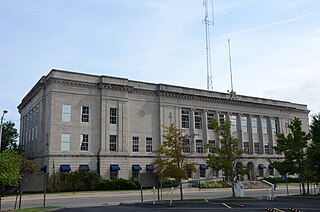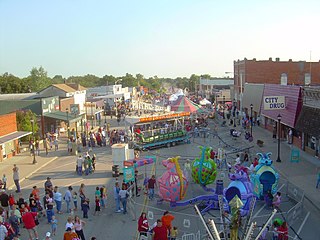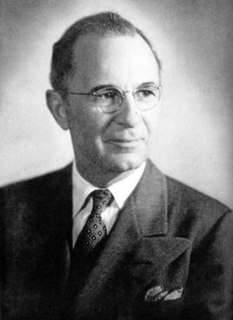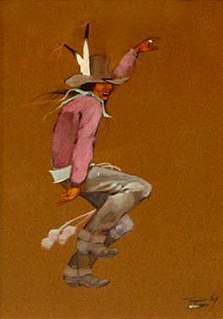Related Research Articles

Muskogee County is a county located in the U.S. state of Oklahoma. As of the 2010 census, the population was 70,990. The county seat is Muskogee. The county and city were named for the Muscogee (Creek) Nation. The official spelling of the name was changed to Muskogee by the post office in 1900.
Haskell is a town in Muskogee County, Oklahoma, United States. The population was 2,007 at the 2010 census, a gain of 13.7 percent over the figure of 1,765 recorded in 2000. Haskell was established in 1904 on the Midland Valley Railroad. It was named for town site developer Charles N. Haskell, who would become the first governor of the State of Oklahoma in 1907.

Okmulgee is a city in, and the county seat of, Okmulgee County, Oklahoma. The name is from the Mvskoke word okimulgee, which means "boiling waters". The site was chosen because of the nearby rivers and springs. Okmulgee is 38 miles south of Tulsa and 13 miles north of Henryetta via US-75. Okmulgee is part of the Tulsa Metropolitan Area.

Coweta is a city in Wagoner County, Oklahoma, United States, a suburb of Tulsa. As of 2010, its population was 9,943. Part of the Creek Nation in Indian Territory before Oklahoma became a U.S. state, the town was first settled in 1840.

William Thomas Gilcrease was an American oilman, art collector, and philanthropist. During his lifetime, Gilcrease collected more than 10,000 artworks, 250,000 Native American artifacts and 100,000 rare books and documents, including the only surviving certified copy of the Declaration of Independence. He was the founder of Gilcrease Museum in Tulsa, Oklahoma. In 1971, he was inducted into the Hall of Great Westerners of the National Cowboy & Western Heritage Museum.

Pleasant Porter, was an American Indian statesman and the last elected Principal Chief of the Creek Nation, serving from 1899 until his death.
Samuel Benton Callahan was an influential, mixed blood Creek politician, born in Mobile, Alabama, to a white father, James Callahan, and Amanda Doyle, a mixed-blood Creek woman. One source says that James was an Irishman who had previously been an architect or a shipbuilder from Pennsylvania, while Amanda was one-eighth Muscogee. His father died while he was young; he and his mother were required to emigrate to Indian Territory in 1836. His mother married Dr. Owen Davis of Sulphur Springs, Texas, where they raised Samuel.

Bacone College, formerly Bacone Indian University, is a tribal college in Muskogee, Oklahoma. Founded in 1880 as the Indian University by missionary Almon C. Bacone, it was originally affiliated with the mission arm of what is now American Baptist Churches USA. Renamed as Bacone College in the early 20th century, it is the oldest continuously operated institution of higher education in Oklahoma. The liberal arts college has had strong historic ties to several tribal nations, including the Muscogee and Cherokee. The Bacone College Historic District is listed on the National Register of Historic Places.

Acee Blue Eagle was a Native American artist, educator, dancer, and Native American flute player, who directed the art program at Bacone College. His birth name was Alexander C. McIntosh, he also went by Chebon Ahbulah, and Lumhee Holot-Tee, and was an enrolled member of the Muscogee (Creek) Nation.

The Muscogee (Creek) Nation, rebranded in May of 2021 as simply the Muscogee Nation, is a federally recognized Native American tribe based in the U.S. state of Oklahoma. The nation descends from the historic Creek Confederacy, a large group of indigenous peoples of the Southeastern Woodlands. Official languages include Muscogee, Yuchi, Natchez, Alabama, and Koasati, with Muscogee retaining the largest number of speakers. They commonly refer to themselves as Este Mvskokvlke. Historically, they were often referred to by European Americans as one of the Five Civilized Tribes of the American Southeast.
Tullahassee Mission was a Presbyterian mission and school, founded on March 1, 1850 in the Creek Nation, Indian Territory by Robert Loughridge. This Presbyterian minister had been serving there since 1843, when he founded Koweta Mission. This mission was also originally built for Muscogee Creek students, and the community of Tullahassee developed there.

Robert McGill Loughridge was an American Presbyterian missionary who served among the Creek in Indian Territory. He attended Miami University, Ohio, and graduated in 1837. Loughridge was ordained as a Presbyterian minister in October 1842.
The Sequoyah Constitutional Convention was an American Indian-led attempt to secure statehood for Indian Territory as an Indian-controlled jurisdiction, separate from the Oklahoma Territory. The proposed state was to be called the State of Sequoyah.
The Bacone school or Bacone style of painting, drawing, and printmaking is a Native American intertribal "Flatstyle" art movement, primarily from the mid-20th century in Eastern Oklahoma and named for Bacone College. This art movement bridges historical, tribally-specific pictorial painting and carving practices towards an intertribal Modernist style of easel painting. This style is also influenced by the art programs of Chilocco Indian School, north of Ponca City, Oklahoma, and Haskell Indian Industrial Training Institute, in Lawrence, Kansas and features a mix of Southeastern, Prairie, and Central Plains tribes.

Jerome Richard Tiger (1941–1967) was a highly influential Native American painter from Oklahoma. Tiger produced hundreds of paintings from 1962 until his death in 1967.
James Pepper Henry is a Native American museum director and vice-chairman of the Kaw Nation. He is the executive director of the First Americans Museum in Oklahoma City, Oklahoma, which is scheduled to open in the fall of 2021.

Lilah Denton Lindsey was an American philanthropist, civic leader, women's community organizer, temperance worker, and teacher. She was the first Creek woman to earn a college degree. She led numerous civic organizations and served as president of the Indian Territory Woman's Christian Temperance Union (WCTU).
Jimmie Carole Fife Stewart is a Muscogee (Creek) art educator, fashion designer and artist. After graduating from the Chilocco Indian School and taking courses at the University of Arizona, she earned a degree from Oklahoma State University and began working as a teacher. After a six year stint working for Fine Arts Diversified, she returned to teaching in 1979 in Washington, Oklahoma. Primarily known as a painter, using watercolor or acrylic media, Fife-Stewart has also been involved in fashion design. Her works have been shown mostly in the southwestern United States and have toured South America. Having won numerous awards for her artworks, she was designated as a Master Artist by the Five Civilized Tribes Museum in 1997.

Solomon McCombs was a Native American artist from Oklahoma known for his paintings, murals, and illustrations.
References
- 1 2 3 Bixby Historical Society."Settlers Claim Land." Retrieved April 29, 2013.
- ↑ Anderson, Dan. One Hundred Oklahoma Outlaws, Gangsters, and Lawmen, 1839-1939 p. 12. 2007. Retrieved April 24, 2013. Available on Google Books.
- ↑ Mullins, Jonita. "Three Forks History: First Chisholm Trail came through Green Country". Muskogee Phoenix. Retrieved 2019-12-11.
- ↑ "Transcription of interview with Lilah D. Lindsay", University of Oklahoma Libraries Western History Collections. Volume 54. Interview ID 1235. An Interview with Lilah D. Lindsay {sic} by Effie S. Jackson. December 7, 1937.
- ↑ "Tulsa County Historic Sites :: TULSA AND OKLAHOMA HISTORY COLLECTION". cdm15020.contentdm.oclc.org. Retrieved 2019-12-11.